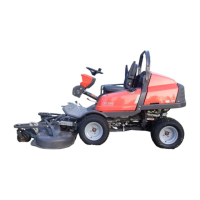English-35
DESIGN AND FUNCTION
Brakes
The machine’s hydrostatic drive system is used as the service brake. If you release the drive pedals they
spring back to zero feed of the drive system's hydraulic pump and the machine stops. It is also possible to
press down the pedal for the opposite driving direction. This results in a sudden halt and the driving direc-
tion changes if the pedal is not released.
The parking brake works using two drum brakes located between front wheels and its hydraulic motors.
The parking brake pedal actuates the drum brakes with two wires. Adjuster screws (R and L) are posi-
tioned on the wires' upper attachment. On the lower attachments are springs, which are required in order
for the pedal not to be rigid, in which case the parking brake lock would not work.
The parking brake lock is located in front of the pedal's bearing. It distinguishes between the model years.
Model year 2006 has a spring loaded bell crank, whose lower part locks the pedal. The upper part protrudes
from under the seat cushion and is used for releasing the parking brake.
Beginning with model year 2007, the parking brake lock is controlled by a spring which runs overcentre
depending on the lock handle position.
If you pull up the lock handle, the lock is pushed against the pedal by spring force. When you press down
the pedal it will be caught by the lock.
If you press down the lock handle, the spring force will act so that the pedal lock is released, but the lock
cannot release its grip until the pedal is pressed down.
8043-018, 8043-158
Parking brake model year 2007-

